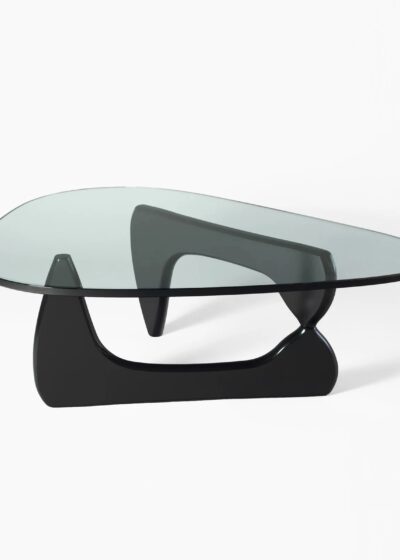Noguchi
A Sculpture for Everyday Life: The Enduring Allure of the Noguchi Coffee Table
In the pantheon of modernist furniture, few pieces resonate with the enduring grace and sculptural beauty of the Noguchi coffee table. Conceived in 1944 by the Japanese-American artist Isamu Noguchi, this seemingly simple form transformed the utilitarian into an objet d’art, blurring the lines between art and functionality. Today, it endures as a timeless icon, adorning living rooms and museums alike, its origins and evolution whispering tales of artistic vision and post-war design.
From Biomorphism to Balance:
The Noguchi table emerged from a confluence of artistic influences. Noguchi, steeped in the biomorphic forms of Surrealism, sought to infuse organic shapes into his sculptural works. This desire gave birth to the table’s signature form: two curving wooden legs gracefully supporting a glass top, resembling a playful interplay of nature and geometry. Yet, beneath this artistic whimsy lay a meticulous study of balance and proportion. The table’s asymmetrical stance, defying the rigidity of conventional furniture, was precisely calculated to ensure stability and visual harmony.
A Collaboration of Vision:
The table’s journey from artistic conception to mass production was paved by a visionary collaboration. George Nelson, design director at Herman Miller, recognized the table’s potential and brought his keen eye for innovation to the project. He spearheaded the transition from the original rosewood prototype to the sleek walnut and glass iteration that became the iconic Herman Miller model. This marriage of artistic expression and commercial acumen ensured the table’s accessibility to a wider audience, transforming it from a singular artistic statement into a symbol of the mid-century modern movement.
Beyond Function, an Experience:
The Noguchi table’s true significance lies not only in its aesthetic, but in its experiential nature. Unlike a mere static object, it invites interaction, its smooth glass surface and organic form evoking a sense of tactility and playful balance. It becomes a stage for everyday life, a backdrop for conversations, coffee mornings, and quiet moments of contemplation. Its inherent sculptural quality infuses even the most mundane rituals with a touch of aesthetic grace, reminding us that beauty can be found in the seemingly ordinary.
A Legacy in Glass and Wood:
Today, the Noguchi coffee table remains a timeless testament to its creator’s artistic vision. Its elegant presence graces both modern and traditional spaces, its classicism defying trends and evolving tastes. Each curve of the wood, each reflection on the glass surface, whispers the story of its artistic origins and collaborative birth. In a world ever-chasing novelty, the Noguchi table stands as a reminder that true design transcends time, offering a lasting dialogue between art, functionality, and the poetry of everyday living.
This article delves into the artistic inspirations, historical context, and lasting impact of the Noguchi coffee table. Feel free to suggest any specific details you’d like me to elaborate on, or any additional information you think would enrich the narrative. My goal is to create a comprehensive and engaging piece that captures the essence of this iconic design and its enduring legacy.
Showing the single result


